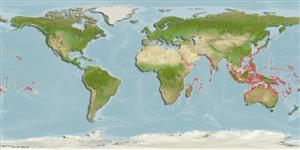Common names from other countries
Environment: milieu / climate zone / depth range / distribution range
экология
морской ассоциированный с рифами; пределы глубины 1 - 20 m (Ref. 90102). Tropical; 32°N - 32°S
Indo-Pacific: Red Sea south to Knysna, South Africa (Ref. 4404) and east to Tuamoto Islands, north to southern Japan, south to northern New South Wales; Palau to eastern Caroline Islands, Marshall Islands in Micronesia.
Size / Вес / Возраст
Maturity: Lm ? range ? - ? cm
Max length : 12.0 cm TL самец/пол неопределен; (Ref. 9710)
Краткое описание
определительные ключи | морфология | морфометрия
колючие лучи спинного плавника (общее число) : 9 - 11; членистые (мягкие) лучи спинного плавника (общее число) : 28 - 34; колючие лучи анального плавника: 2; членистые (мягкие) лучи анального плавника: 25 - 30. A. dussumieri differs from the A. taeniatus taeniatus by having a nearly terminal mouth and different color pattern, sometimes with elongate ocellus in front of dorsal fin (Ref. 37816). Indonesian populations have long yellow filaments on caudal fin. Recognized by the slender body and single dark mid-lateral stripe from the tip of the snout to the caudal fin (Ref. 48636).
Common in coral reefs and rocky areas (Ref. 559, 637). Feed on algae and detritus. Generally a shy species that quickly retreats to its hiding holes, usually empty tube-worm homes, retreating backwards (Ref. 48636). Oviparous. Eggs are demersal and adhesive (Ref. 205), and are attached to the substrate via a filamentous, adhesive pad or pedestal (Ref. 94114). Larvae are planktonic, often found in shallow, coastal waters (Ref. 94114).
Life cycle and mating behavior
Maturities | размножение | Spawnings | Egg(s) | Fecundities | личинки
Distinct pairing (Ref. 205).
Myers, R.F., 1991. Micronesian reef fishes. Second Ed. Coral Graphics, Barrigada, Guam. 298 p. (Ref. 1602)
Статус Красного Списка МСОП (Ref. 130435)
CITES (Ref. 128078)
Not Evaluated
Угроза для людей
Harmless
Использование человеком
рыболовство: коммерческий; аквариум: коммерческий
дополнительная информация
инструменты
Специальные отчеты
Скачать в формате XML
ресурсы в Интернет
Estimates based on models
Preferred temperature (Ref.
115969): 24.7 - 29.3, mean 28.4 (based on 3320 cells).
Phylogenetic diversity index (Ref.
82804): PD
50 = 0.6250 [Uniqueness, from 0.5 = low to 2.0 = high].
Bayesian length-weight: a=0.00562 (0.00258 - 0.01228), b=3.06 (2.87 - 3.25), in cm Total Length, based on LWR estimates for this (Sub)family-body shape (Ref.
93245).
Trophic level (Ref.
69278): 2.0 ±0.00 se; based on food items.
устойчивость к внешним воздействиям (Ref.
120179): высокий, минимальное время удвоения популяции до 15 месяцев (Preliminary K or Fecundity.).
Fishing Vulnerability (Ref.
59153): Low vulnerability (10 of 100).
